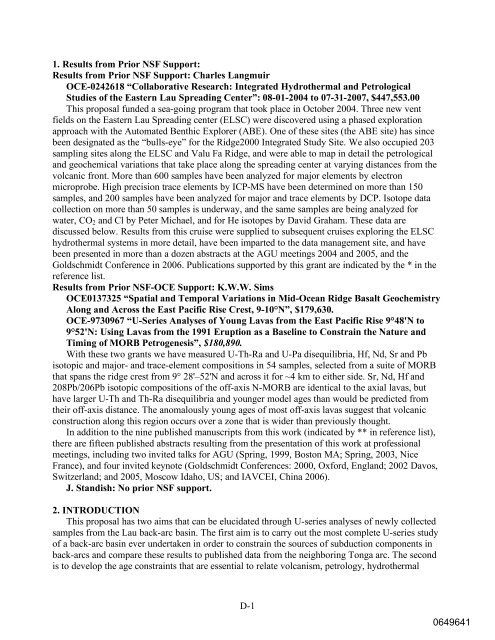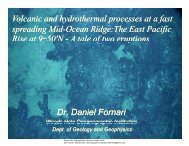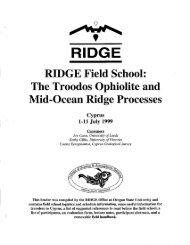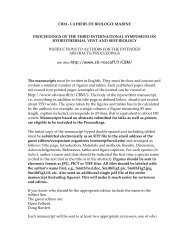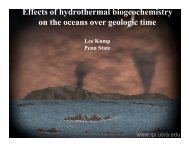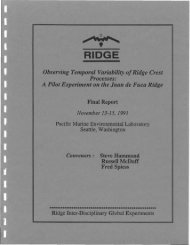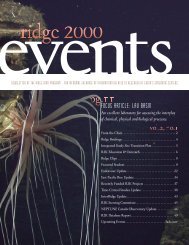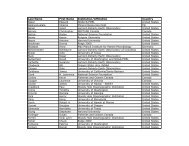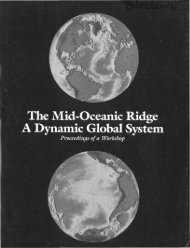NSF Forms - Ridge 2000 Program
NSF Forms - Ridge 2000 Program
NSF Forms - Ridge 2000 Program
Create successful ePaper yourself
Turn your PDF publications into a flip-book with our unique Google optimized e-Paper software.
1. Results from Prior <strong>NSF</strong> Support:<br />
Results from Prior <strong>NSF</strong> Support: Charles Langmuir<br />
OCE-0242618 “Collaborative Research: Integrated Hydrothermal and Petrological<br />
Studies of the Eastern Lau Spreading Center”: 08-01-2004 to 07-31-2007, $447,553.00<br />
This proposal funded a sea-going program that took place in October 2004. Three new vent<br />
fields on the Eastern Lau Spreading center (ELSC) were discovered using a phased exploration<br />
approach with the Automated Benthic Explorer (ABE). One of these sites (the ABE site) has since<br />
been designated as the “bulls-eye” for the <strong>Ridge</strong><strong>2000</strong> Integrated Study Site. We also occupied 203<br />
sampling sites along the ELSC and Valu Fa <strong>Ridge</strong>, and were able to map in detail the petrological<br />
and geochemical variations that take place along the spreading center at varying distances from the<br />
volcanic front. More than 600 samples have been analyzed for major elements by electron<br />
microprobe. High precision trace elements by ICP-MS have been determined on more than 150<br />
samples, and 200 samples have been analyzed for major and trace elements by DCP. Isotope data<br />
collection on more than 50 samples is underway, and the same samples are being analyzed for<br />
water, CO 2 and Cl by Peter Michael, and for He isotopes by David Graham. These data are<br />
discussed below. Results from this cruise were supplied to subsequent cruises exploring the ELSC<br />
hydrothermal systems in more detail, have been imparted to the data management site, and have<br />
been presented in more than a dozen abstracts at the AGU meetings 2004 and 2005, and the<br />
Goldschmidt Conference in 2006. Publications supported by this grant are indicated by the * in the<br />
reference list.<br />
Results from Prior <strong>NSF</strong>-OCE Support: K.W.W. Sims<br />
OCE0137325 “Spatial and Temporal Variations in Mid-Ocean <strong>Ridge</strong> Basalt Geochemistry<br />
Along and Across the East Pacific Rise Crest, 9-10°N”, $179,630.<br />
OCE-9730967 “U-Series Analyses of Young Lavas from the East Pacific Rise 9°48'N to<br />
9°52'N: Using Lavas from the 1991 Eruption as a Baseline to Constrain the Nature and<br />
Timing of MORB Petrogenesis”, $180,890.<br />
With these two grants we have measured U-Th-Ra and U-Pa disequilibria, Hf, Nd, Sr and Pb<br />
isotopic and major- and trace-element compositions in 54 samples, selected from a suite of MORB<br />
that spans the ridge crest from 9° 28'–52'N and across it for ~4 km to either side. Sr, Nd, Hf and<br />
208Pb/206Pb isotopic compositions of the off-axis N-MORB are identical to the axial lavas, but<br />
have larger U-Th and Th-Ra disequilibria and younger model ages than would be predicted from<br />
their off-axis distance. The anomalously young ages of most off-axis lavas suggest that volcanic<br />
construction along this region occurs over a zone that is wider than previously thought.<br />
In addition to the nine published manuscripts from this work (indicated by ** in reference list),<br />
there are fifteen published abstracts resulting from the presentation of this work at professional<br />
meetings, including two invited talks for AGU (Spring, 1999, Boston MA; Spring, 2003, Nice<br />
France), and four invited keynote (Goldschmidt Conferences: <strong>2000</strong>, Oxford, England; 2002 Davos,<br />
Switzerland; and 2005, Moscow Idaho, US; and IAVCEI, China 2006).<br />
J. Standish: No prior <strong>NSF</strong> support.<br />
2. INTRODUCTION<br />
This proposal has two aims that can be elucidated through U-series analyses of newly collected<br />
samples from the Lau back-arc basin. The first aim is to carry out the most complete U-series study<br />
of a back-arc basin ever undertaken in order to constrain the sources of subduction components in<br />
back-arcs and compare these results to published data from the neighboring Tonga arc. The second<br />
is to develop the age constraints that are essential to relate volcanism, petrology, hydrothermal<br />
D-1<br />
0649641


